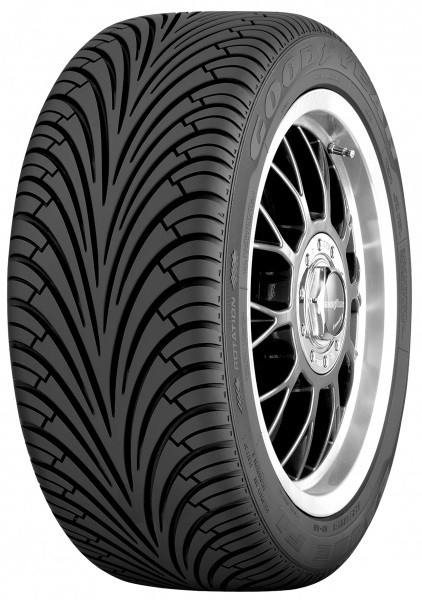Like its predecessor, the Goodyear Eagle F1 GS-D2 summer tire has been developed using technologies previously used exclusively in motorsport. It could not be otherwise, since this model is the flagship, and in addition, it is designed for the most powerful and high-speed modifications of modern passenger cars. The effectiveness of its design can be judged by the fact that many of the solutions used in them have found application in several other Goodyear models.
OneTred shoulder areas
One such solution is OneTred shoulder technology. It complements the well-known V-Tred technology for many years. Its essence lies in the presence of a large number of double tread blocks in the shoulder areas of the tread, which are a continuation of their "colleagues" located in the central part of the tread.
Their double design has improved several important performance properties at once. Most of them, to one degree or another, is a direct consequence of the increase in the size of the contact spot and giving it an almost square shape. This resulted in improved stability and grip reliability in cornering and braking. In addition, the double block design provides increased resistance to aquaplaning.
Multifunctional centerpiece design
In turn, the design of the center of the tread of this tire is characterized by its versatility. It is ensured by the presence of rigid bridges between the diagonal blocks. On the one hand, this gives the tire stability in straight-line movement and control efficiency, and on the other hand, it prevents the occurrence of the aquaplaning effect.
Main features of the Goodyear Eagle F1 GS-D2 tire
OneTred shoulder design with multiple dual-block designs improves braking performance and grip when cornering.
- rigid bridges in the center of the tread between the diagonal blocks form a continuous longitudinal rib, which improves traction and directional stability at high speed.
At the heart - slick
Modern UHP tires must provide almost the same grip on dry asphalt as racing slick tires, efficiently drain water from the contact patch in the rain, and provide comfort in normal driving conditions. Combining these sometimes polar properties was helped by the OneTRED single tread technology. It is based on a sports slick. The new Eagle F1 tires have no longitudinal grooves at all, as well as no transverse grooves. The role of both is played by long V-shaped slots, along which large volumes of water are easily removed from the contact patch. The rest of the tread area is without any grooves (grooves in the shoulder area do not count). This increases the tread rigidity in both the lateral and longitudinal directions. On the centerline, the tread surrounds a single ring, which provides stability at high speeds and precise vehicle response at low steering angles. Compared to the previous generation of Eagle F1 tires, the profile of the new tires has been optimized. This made it possible to obtain a more even distribution of loads in the contact patch with the road. The composition of the rubber compound was not disclosed, but polymers developed by the Goodyear Racing division are known to have been used.
EagleF1 GS-D3 In terms of comfort, the new tires are no different from the previous model in terms of ride comfort. But they are quieter - if you look closely at the tread, you will notice that the grooves on the left and right are located asymmetrically - as if a skier skated along with the tire. Such a scheme allows you to get rid of the resonant frequencies that symmetrical patterns suffer from. By the way, initially, the tread of the new F1 tires was also symmetrical, but in the process of fine-tuning, the engineers abandoned this scheme.
And finally, on the side surface of the Eagle F1 tires, there is a protective collar, which in the event of a collision with an obstacle - for example, on a curb - will protect the expensive alloy wheel from damage.
The chart shows the performance of the Goodyear Eagle F1 GS-D3 as compared to the previous GS-D2, as a percentage.
On flat tires
Extended Mobility Tires (EMT) technology is no longer new. Back in 1992, Goodyear developed the Eagle GS-C EMT tires, which they soon began offering as optional equipment for Chevrolet Corvette vehicles. And since 1997, EMT tires have been included in the list of standard equipment for the new Corvette.
section In normal conditions, i.e. under pressure, EMT tires are not much different from normal tires. But in the event of a puncture, the EMT tires do not "smear" on the asphalt: the car only sags slightly and can continue to move at a speed of up to 80 km / h for an hour. No spare wheel needed, no jack too. The main thing is that the nearest tire fitting should be no more than 65 miles away, and even there the tire will be repaired traditionally.
The fact is that the carcass is reinforced in these tires, and there are inserts in the sidewalls that prevent them from folding.
But to prevent the tires from jumping off the rims, bead cores are used here to ensure a firm fit of the tire on the rim. By the way, the new generation EMT tires differ from those we introduced to our readers in 1997 (see AP # 20, 1997), namely by the side inserts made of new materials, which made it possible to reduce the weight and internal friction in the punctured tire.
Since 2001, EMT technology has been used not only on the expensive Eagle F1 tires but also on the more affordable ones - NCT 5. The latter, by the way, are already equipped with a new Mini.
Goodyear and Siemens VDO are now jointly developing a remote driver warning system for low tire pressure. The difference from the existing solutions is that the system will correct the operation of the ABS and motion stabilization systems in the event of a puncture.

